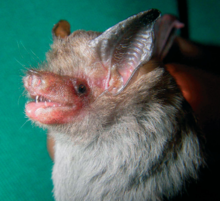
Back خفاش طنان Arabic خفاش طنان ARZ Craseonycteris thonglongyai AST Свиненос прилеп Bulgarian কিটির শূকর-নাসা বাদুড় Bengali/Bangla Craseonicteri de nas porcí Catalan Craseonycteris thonglongyai CEB Netopýrek thajský Czech Humlebiflagermus Danish Schweinsnasenfledermaus German
| Kitti's hog-nosed bat | |
|---|---|

| |
| Scientific classification | |
| Domain: | Eukaryota |
| Kingdom: | Animalia |
| Phylum: | Chordata |
| Class: | Mammalia |
| Order: | Chiroptera |
| Superfamily: | Rhinolophoidea |
| Family: | Craseonycteridae Hill, 1974 |
| Genus: | Craseonycteris Hill, 1974 |
| Species: | C. thonglongyai
|
| Binomial name | |
| Craseonycteris thonglongyai Hill, 1974
| |

| |
| Kitti's hog-nosed bat range | |
Kitti's hog-nosed bat (Craseonycteris thonglongyai), also known as the bumblebee bat, is a near-threatened species of bat and the only extant member of the family Craseonycteridae. It occurs in western Thailand and southeast Myanmar, where it occupies limestone caves along rivers.
Kitti's hog-nosed bat is the smallest species of bat and arguably the world's smallest mammal by body length (the Etruscan shrew is regarded as the smallest by body mass). It has a reddish-brown or grey coat, with a distinctive pig-like snout. Colonies range greatly in size, with an average of 100 individuals per cave. The bat feeds during short activity periods in the evening and dawn, foraging around nearby forest areas for insects. Females give birth annually to a single offspring.
Although the bat's status in Myanmar is not well known, the Thai population is restricted to a single province and may be at risk of extinction. Its potential threats are primarily anthropogenic, and include habitat degradation and the disturbance of roosting sites.[1]
- ^ a b Bates, P.; Bumrungsri, S.; Francis, C. (2019). "Craseonycteris thonglongyai". IUCN Red List of Threatened Species. 2019: e.T5481A22072935. doi:10.2305/IUCN.UK.2019-3.RLTS.T5481A22072935.en. Retrieved 20 May 2023.
